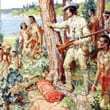The contemporary French character is many times the object of Yankee derision. After all, these are the folks who in the 20th century laid down for the Germans, accommodated the Soviets, gave us Pétain, Sartre, and Foucault, and admired Jerry Lewis. And they’ve made a fetish at looking down their Gallic noses at most Americans, even those who rescued them twice (three times if you count the Cold War) from tyranny. Years ago, a friend returning from Europe told me that Paris would be a swell place but for all those Frenchmen.
I’ve been rereading parts of the two-volume Library of America editions of Francis Parkman’s France and England in North America for another article, and I’m reminded how adventurous the French once were as compared to those stodgy, provincial Brits. In the 17th century they were a livelier bunch, and they certainly got around.
The British North American colonial experience is familiar (well, it used to be) to us thanks to the grammar school American History textbooks of another time (I remember how delighted I was to be handed my first one in the fourth grade). History books were actually constructed with interesting narratives back then. The Pilgrims at Plymouth Rock and their first hard years in New England. Those swashbuckling cavaliers who founded Jamestown, but couldn’t properly settle the Virginia Tidewater without instituting the evil of the “peculiar institution” of slavery. And lighthearted stuff, like Ben Franklin flying kites in thunderstorms, and inventing a new stove and reading glasses.
But the British were hemmed in by the Atlantic and the Appalachians, though why such relatively low mountains posed a barrier to westward expansion is interesting to contemplate. It took Massachusetts almost a century to expand a hundred miles west to the Connecticut River. Pennsylvania populated Philadelphia, the Delaware Valley and farmland immediately to the west, but farther west still range after range of the mountains hampered settlement. It was the same for Virginia beyond the Piedmont. The British colonies clung to the seaboard to better enjoy the security offered by the British Navy, but also because they lacked a river to connect them to the continent’s interior.
The French had the St. Lawrence River as an avenue to the West. After founding Quebec in 1608, the restless Samuel de Champlain was by 1615 exploring by canoe the shores of Lake Huron. The Pilgrims hadn’t set foot on Plymouth Rock yet. Champlain sent another party west commanded by a young man named Etienne Brulé, and in 1623 Brulé reached “the Sault,” the bottleneck of land between Lakes Huron and Superior that figured so prominently in North American history. Brulé was the first white man to see all five Great Lakes. In 1634, another “coureur de bois” (“runner of the woods,” a trader) named Jean Nicolet arrived at Green Bay on Lake Michigan thinking he had landed in China. The presence of the local-friendly Winnebago Indians convinced Nicolet that he was a bit off course. So, by 1634 the French had reached the 88th Meridian. A year later Concord, Massachusetts, was founded, just sixteen miles west of Boston.
All through the 17th century the French and their French-Canadian progeny paddled the Great Lakes and explored the vast expanses of forest and prairie to the north and west. They trapped and traded and dealt with Indians both friendly and hostile. Father Jacques Marquette and Louis Joliet first descended the Mississippi River as far south as the mouth of the Arkansas River in 1673. In 1683, Robert Cavelier Sieur de La Salle floated the great river to its mouth, thus adding a nebulous garment called “Louisiana” for Louis XIV to hang in his closet at Versailles.
The dawn of the 18th century saw the French build the forts that would become the cities of Detroit (Antoine de La Mothe-Cadillac, 1701) and New Orleans (Jean Baptiste Le Moyne de Bienville, 1718). In 1719, Bénard de La Harpe ascended the Red River as he sought for trade the Comanches of present Texas. He couldn’t find them. In 1721, Etienne de Bourgmond did. And he may have been the first man ever to kill a buffalo from horseback using a flintlock pistol. Only two years later, young Ben Franklin arrived in Philadelphia to make his fortune starting with “a Dutch dollar” in his pocket. He was 17 and had come from his hometown of Boston. Not taking anything away from the precocious, hustling Franklin; he’d never been to the Southern Plains, in fact, couldn’t comprehend them. As for a buffalo, whether he’d heard of them is one thing, but he’d never seen one, much less killed one.
In 1739, two brothers, Pierre and Paul Mallet, and four friends wandered into Santa Fe after traveling south from the Platte River across present Kansas and Colorado. They were there illegally because it was Spanish territory and they were French-Canadians, but were unmolested and stayed the winter, traveling back to Louisiana in the spring of 1740 by way of the Arkansas and the Mississippi. In 1743, two other brothers, Pierre and Chevalier La Verendrye, at the head of another party of coureurs de bois gazed upon the “Shining Mountains,” or the Bighorns, part of the first line of the Rockies in today’s Wyoming.
A lot of geopolitical factors went into the loss of the North American continent by the French to the British following the Seven Years War and the Treaty of Paris of 1763. But lack of knowledge of that great vast wilderness wasn’t one of them.
























